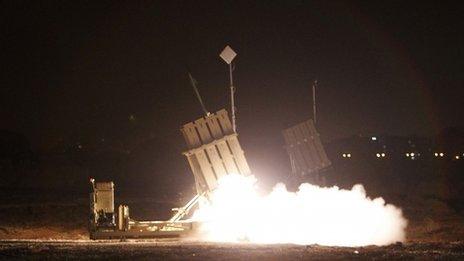How did Iron Dome perform over course of Gaza clash?
- Published
- comments

Both sides in the Gaza fighting are turning their minds to digesting the lessons of this short, sharp, campaign. For the Israeli government, anxious to dismiss the impression that it has not been humiliated by Hamas, much emphasis is being placed on the success of its Iron Dome defence system.
According to figures released by the Israeli defence ministry these new anti-missile batteries opened up 573 times, knocking down 421 out of 1,506 missiles fired from Gaza.
Some have even speculated that the success of the missile has mitigated the fact that Hamas or Hezbollah can now hit Israel's most important population and economic centres, a factor that cannot be overlooked in looking forward to the possible consequences of a strike against Iran's nuclear facilities.
Let us deal with the upside for the Israelis first. The fact that Iron Dome was only used against just over one third of the projectiles fired is a measure of its advanced fire control computers rather than its limitations. By tracing the trajectory of the Palestinian missile within the first few seconds of its flight, the system could calculate whether or not it was heading for a populated area and therefore whether the firing of a defensive interceptor missile was necessary.
Calculating the firing solutions so quickly on multiple projectiles heading your way is indeed impressive. An unnamed US air defence officer quoted by the New York Times argues, "this discrimination is a very important part of all missile defence systems… this clearly has been a validation of the Iron Dome system's capability".
Luckily for the Israelis, most of the missiles fired at them were heading for the barren Negev desert or hillsides within the (Palestinian) West Bank. They say that 875 of them, more than half of the total fired, landed in uninhabited areas.
When it comes to the ability to hit the many Palestinian firing points, clearly very difficult targets since they are often nestling against homes, schools, or mosques, the capability demonstrated by the Israeli Defence Forces has however been less impressive.
Throughout the brief conflict Israeli experts such as Brigadier General Michael Herzog, who Newsnight interviewed earlier this week, said that the rate of missile firings had lessened significantly as their strikes against the Palestinians went on, and indeed the statistics released during the conflict by the defence ministry in Tel Aviv suggested that this was indeed the case.
However the figures that have now emerged hardly support this view. The numbers fired on each day of the conflict were: 75 on the first; then 316 on the second; then 228; 237; 156; 143; 221 on the last full day; and 130 on the day the ceasefire was agreed. The figure of 221 near the end is significant in this regard.
While there have been claims of "massive damage" to the estimated stockpile of 10,000 Hamas missiles, the organisation itself - unsurprisingly - maintains that it still retains substantial stocks, including of longer range weapons, that had been hidden on the assumption that the conflict might last weeks.
Airstrikes were evidently patchy in their results, as they were in the 2006 Lebanon conflict or the 2008-9 campaign against Hamas.
Where does all of this leave the calculation of missile defence and how effective it can be? Certainly the apparent success of Iron Dome has changed the calculus for the future. More batteries will be deployed, and there will be further refinements to its software.
However Hamas and Hezbollah can hardly be expected to stand still either. If they improve their launch accuracy to the point that the majority rather than minority of their missiles are on target, would Iron Dome be able to cope?
Luck comes into this too, and if Hamas had scored a hit resulting in a major loss of life, the sense of insecurity felt by Israelis might have been much more profound.
Missile defence may be able to play a significant part in blunting this threat. But the fact that peace process rejectionists such as Hamas and Hezbollah now have such extensive means of hitting Israeli cities is the more important strategic development.